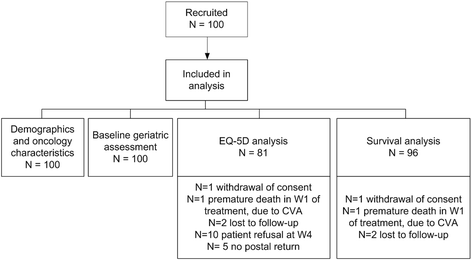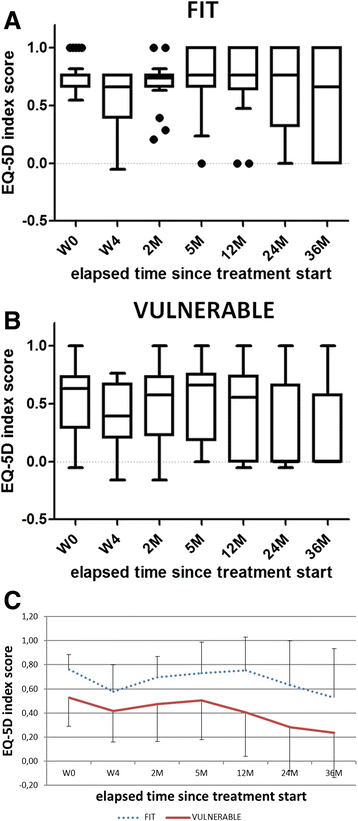G-8 indicates overall and quality-adjusted survival in older head and neck cancer patients treated with curative radiochemotherapy
- PMID: 26553007
- PMCID: PMC4640221
- DOI: 10.1186/s12885-015-1800-1
G-8 indicates overall and quality-adjusted survival in older head and neck cancer patients treated with curative radiochemotherapy
Abstract
Background: Evidence-based guidelines concerning the older head and neck cancer (HNCA) patient are lacking. Accurate patient selection for optimal care management is therefore challenging. We examined if geriatric assessment is indicative of long-term health-related quality of life (HRQOL) and overall survival in this unique population.
Methods: All HNCA patients, aged ≥65 years, eligible for curative radio(chemo)therapy were evaluated with the Geriatric-8 (G-8) questionnaire and a comprehensive geriatric assessment (CGA). Euroqol-5 dimensions (EQ-5D) and survival were collected until 36 months post treatment start. Repeated measures ANOVA was applied to analyse HRQOL evolution in 'fit' and 'vulnerable' patients, defined by G-8. Kaplan-Meier curves and cox proportional hazard analysis were established for determination of the prognostic value of geriatric assessments. Quality-adjusted survival was calculated in both patient subgroups.
Results: One hundred patients were recruited. Seventy-two percent of patients were considered vulnerable according to CGA (≥2 abnormal tests). Fit patients maintained a relatively acceptable long-term HRQOL, whilst vulnerable patients showed significantly lower median health states. The difference remained apparent at 36 months. Vulnerability, as classified by G-8 or CGA, came forward as independent predictor for lower EQ-5D index scores. After consideration of confounders, a significantly lower survival was observed in patients defined vulnerable according to G-8, compared to fit patients. A similar trend was seen based on CGA. Calculation of quality-adjusted survival showed significantly less remaining life months in perfect health in vulnerable patients, compared to fit ones.
Conclusions: G-8 is indicative of quality-adjusted survival, and should be considered at time of treatment decisions for the older HNCA patient.
Figures



References
Publication types
MeSH terms
LinkOut - more resources
Full Text Sources
Other Literature Sources
Medical
Research Materials

